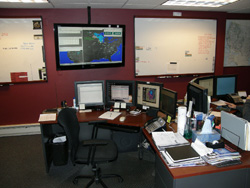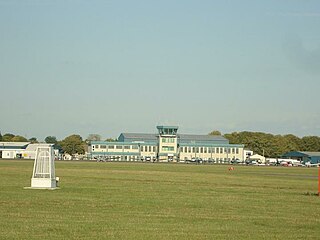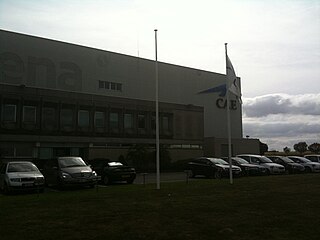
An aircraft pilot or aviator is a person who controls the flight of an aircraft by operating its directional flight controls. Some other aircrew members, such as navigators or flight engineers, are also considered aviators because they are involved in operating the aircraft's navigation and engine systems. Other aircrew members, such as drone operators, flight attendants, mechanics and ground crew, are not classified as aviators.

A flight simulator is a device that artificially re-creates aircraft flight and the environment in which it flies, for pilot training, design, or other purposes. It includes replicating the equations that govern how aircraft fly, how they react to applications of flight controls, the effects of other aircraft systems, and how the aircraft reacts to external factors such as air density, turbulence, wind shear, cloud, precipitation, etc. Flight simulation is used for a variety of reasons, including flight training, the design and development of the aircraft itself, and research into aircraft characteristics and control handling qualities.
The Societé anonyme belge d'Exploitation de la Navigation aérienne, better known by the acronym Sabena or SABENA, was the national airline of Belgium from 1923 to 2001, with its base at Brussels Airport. After its bankruptcy in 2001, SN Brussels Airlines was formed through a takeover of former subsidiary Delta Air Transport and took over part of Sabena's assets in February 2002, which became Brussels Airlines after a merger with Virgin Express in March 2007. The airline's corporate headquarters were located in the Sabena House on the grounds of Brussels Airport in Zaventem.
The airline transport pilot license (ATPL), or in the United States of America, an airline transport pilot (ATP) certificate, is the highest level of aircraft pilot certificate.

CAE Inc. is a Canadian manufacturer of simulation technologies, modelling technologies and training services to airlines, aircraft manufacturers, healthcare specialists, and defence customers. CAE was founded in 1947, and has manufacturing operations and training facilities in 35 countries.

Scottsdale Airport is a municipal airport located 9 miles north of downtown Scottsdale, in Maricopa County, Arizona, United States. Most U.S. airports use the same three-letter location identifier for the FAA and IATA, but Scottsdale Airport is SDL to the FAA and SCF to the IATA.
Pilot licensing or certification refers to permits for operating aircraft. Flight crew licences are issued by the civil aviation authority of each country, which must establish that the holder has met minimum knowledge and experience before issuing licences. The licence, along with the required class or type rating, allows a pilot to fly aircraft registered in the licence issuing state.

The Dassault Falcon 7X is a large-cabin, 5,950-nautical-mile [nmi] range business jet manufactured by Dassault Aviation, the second largest of its Dassault Falcon line. Unveiled at the 2001 Paris Air Show, its first flight took place on 5 May 2005 and it entered service on 15 June 2007. The Falcon 8X, first delivered on 5 October 2016, is derived from the 7X and has an extended range of 6,450 nmi made possible through engine optimization, aerodynamic refinements as well as an increase in fuel capacity. Featuring an S-duct central engine, the 7X, 8X and the Falcon 900 are the only trijets still in production, as of 2024.

Phoenix Goodyear Airport is a public airport in Goodyear, Arizona in Maricopa County, Arizona, United States.

A flight dispatcher assists in planning flight paths, taking into account aircraft performance and loading, enroute winds, thunderstorm and turbulence forecasts, airspace restrictions, and airport conditions. Dispatchers also provide a flight following service and advise pilots if conditions change. They usually work in the operations center of the airline. In the United States and Canada, the flight dispatcher shares legal responsibility with the commander of the aircraft.

Falcon Field is in an airport located in Maricopa County, Arizona. It was originally built 6 miles northeast of Mesa, which owns it. However, it is now within city limits. The National Plan of Integrated Airport Systems for 2017–2021 categorized it as a reliever airport. Scheduled service to Bullhead City on Western Express Air ended in January 2007.

Vršac Airport is a small airport and training facility owned and operated by the SMATSA Aviation Academy. The airport is located in Vršac, Serbia.

Tamworth Airport is a regional airport serving Tamworth, a city in the Australian state of New South Wales. It is located 10 km (6.2 mi) from the town centre, on New Winton Road. The airport is owned and operated by the Tamworth Regional Council and is listed as being 5 nautical miles west of the city. It is also known as Tamworth Regional Airport.

CAE Oxford, part of CAE Inc., is an ab initio flight training network. It provides integrated aviation training and resourcing services. Professional airline pilots have been trained at the Oxford Aviation Academy (OAA) flight school since 1961.

CAE Oxford Aviation Academy Brussels - Sabena Flight Academy is an aviation training organisation created in 1953, and located in Steenokkerzeel (Belgium). The school is now part of CAE Global Academy. The training is performed in Brussels, in Mesa at CAE Oxford Aviation Academy Phoenix . Sabena Flight Academy is one of the oldest airline transport pilot schools in Europe.
The International Association of Aviation Personnel Schools is a worldwide association of pilot schools. The organization was created on 25 October 1995, and was later renamed in 2009 to also include aviation schools not located in Europe.
ATP Flight School is the largest flight training company in the United States. The curriculum focuses on airline-oriented pilot programs at locations across the country. ATP is the leading supplier of professionally trained pilots to the nation's regional airlines.

CAE Douala is an aviation school owned by Canadian group CAE, located at Douala, Cameroon. It was the first civil aviation university in the country.
Pay-to-fly is an aviation industry practice whereby professional pilots assume duty while paying for it. The practice extends to airline training in the form of type ratings with or without employment guarantee, that some pilots pay to increase their marketability. Even though studied, the subject matter is prevented under no regulation.
Urban Air Mobility (UAM) is the use of small, highly automated aircraft to carry passengers or cargo at lower altitudes in urban and suburban areas which have been developed in response to traffic congestion. It usually refers to existing and emerging technologies such as traditional helicopters, vertical-takeoff-and-landing aircraft (VTOL), electrically propelled, vertical-takeoff-and-landing aircraft (eVTOL), and unmanned aerial vehicles (UAVs). These aircraft are characterized by the use of multiple electric-powered rotors or fans for lift and propulsion, along with fly-by-wire systems to control them. Inventors have explored urban air mobility concepts since the early days of powered flight. However, advances in materials, computerized flight controls, batteries and electric motors improved innovation and designs beginning in the late 2010s. Most UAM proponents envision that the aircraft will be owned and operated by professional operators, as with taxis, rather than by private individuals.













